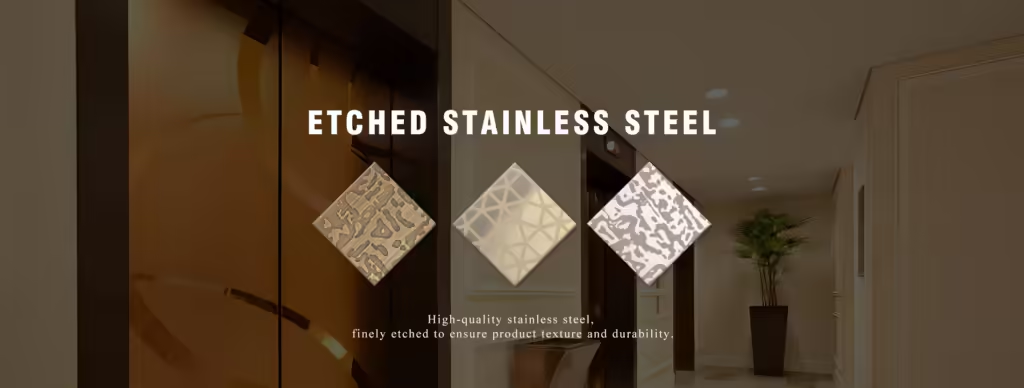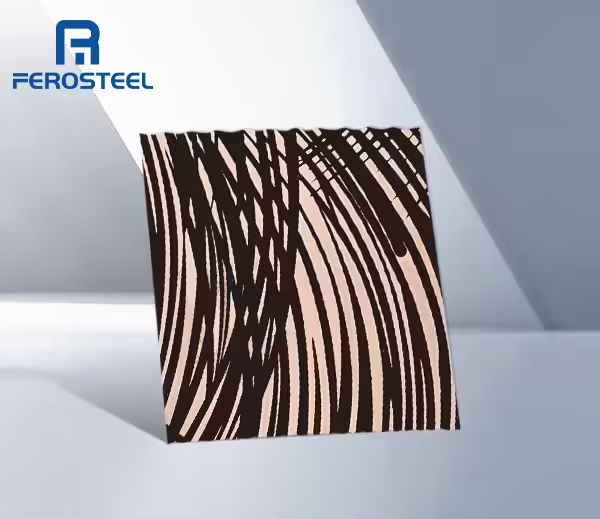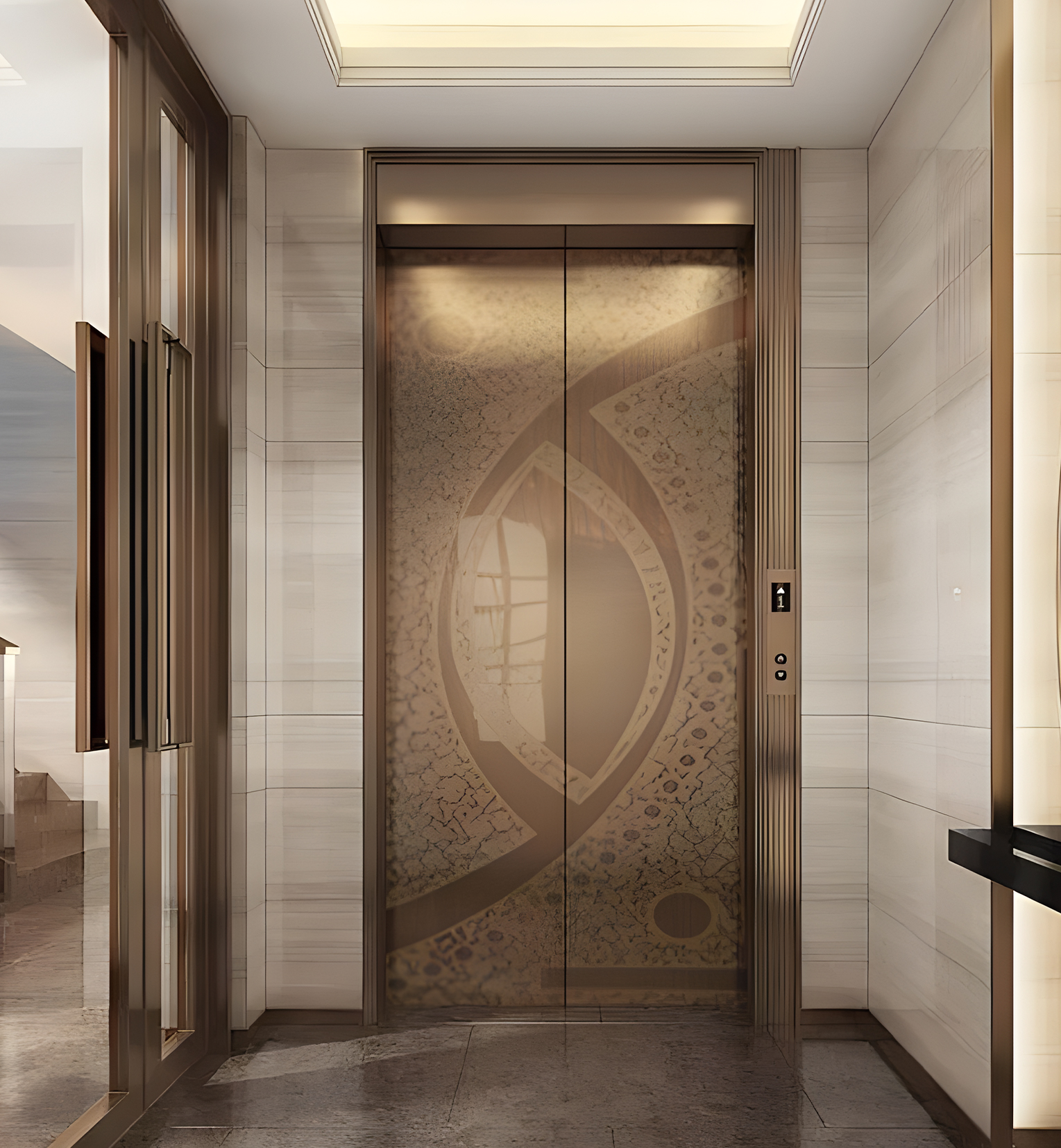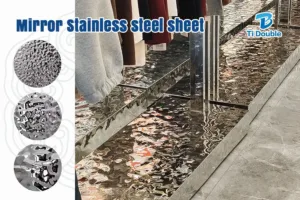Stainless steel etching is a process that creates a fine pattern or texture on the surface of stainless steel by chemical etching or physical etching. This technique allows for the precise removal of minute portions of the material’s surface, resulting in intricate and exquisite patterns. The etching process is widely used in a variety of decorative and functional stainless steel products.

Ⅰ.Production Process of Etching Polished Stainless Steel Sheets
Stainless steel etching is a process that uses chemical or electrochemical methods to create patterns or text on the surface of stainless steel. It is commonly used for decorative and marking purposes. Below is a typical production flow for stainless steel etching:
1. Material Preparation
Choose the appropriate stainless steel sheet, usually 304 or 316 stainless steel. Cut and polish the sheet to the required thickness and size according to customer requirements, ensuring a flat surface.
2. Cleaning and Degreasing
Thoroughly clean the surface of the stainless steel sheet to remove any grease, dirt, and oxide layers. Methods such as pickling, alkali washing, or ultrasonic cleaning can be used.
3. Coating
Evenly apply an anti-corrosion film or resist agent on the surface of the stainless steel sheet, ensuring complete coverage. This film will protect the areas that do not need to be etched.
4. Exposure and Development
Transfer the designed pattern or text onto the anti-corrosion film using exposure equipment. The unmasked areas will be developed, exposing the stainless steel surface.

5. Etching
Immerse the sheet in the etching solution, commonly using hydrochloric acid, nitric acid, or ferric chloride. The etching solution will corrode the exposed stainless steel areas, forming recessed patterns or text. The etching time is adjusted based on the depth of the pattern and the concentration of the etching solution.
6. Cleaning and Stripping
After etching, remove the sheet from the etching solution, thoroughly clean it, and strip off the remaining anti-corrosion film.
7. Post-Processing
If necessary, perform surface treatments on the etched stainless steel, such as polishing, electroplating, or coloring, to enhance decorative effects and corrosion resistance.
8. Inspection and Packaging
Inspect the finished product to ensure the pattern is clear and free of defects. Finally, package the product according to customer requirements and prepare it for shipment.
Each step in this process needs to be strictly controlled to ensure the quality and consistency of the final product.

Ⅱ.Product information
| Product Name | Etching Stainless Steel Sheet |
| Length | 2000mm/2438mm/3000mm/or as required |
| Width | 1000mm/1219mm/1500mm/or as required |
| Thickness | 0.30mm-3.00mm or as required |
| Standard | AISI, JIS, GB, etc |
| Surface Finishing | Mirror/Etching/Brushing/Gold color |
| Thickness Tolerance | ±0.01~0.02mm/or as required |
| Material | 304/316/430/etc |
| Application | Interior and Exterior Decoration,especially used in elevator interiors |
| MOQ | 30 sheets |
| Lead Time | Within 10~30 workdays after receiving deposit |
| Packing | Standard Export Seaworthy Wooden Package/or as required |
| Capacity | 15,000 PCS Production Capability/Month |
Ⅲ. The advantage of etching stainless steel sheets
Durability: Etched stainless steel patterns and text will not fade or wear off, maintaining long-lasting beauty and clarity .
Aesthetics: Fine, high-definition patterns and text can be realised, which is decorative and suitable for high-end decorations and customised designs.
Corrosion resistance: Stainless steel itself has excellent corrosion resistance, which is retained after etching, making it suitable for a variety of environments, including outdoor and wet environments.
Highly customisable: Etching can be personalised according to customer needs, creating a variety of complex patterns and decorative effects.
Environmentally friendly: The etching process does not usually use harmful chemicals, which is environmentally friendly, and the stainless steel itself is a recyclable material.


Ⅳ. Application Scenarios for Etching Polished Stainless Steel Sheets
Etched stainless steel sheets are widely used in various fields due to their excellent corrosion resistance, decorative appeal, and functionality. Here are some common application scenarios:
1. Architectural Decoration
Exterior Wall Decoration: Used for decorative panels on the exterior walls of buildings, providing beautiful patterns and textures while being highly weather-resistant.
Interior Decoration: Used for wall, ceiling, and column decoration, enhancing the aesthetic appeal of interior spaces.
2. Signage and Nameplates
Door Signs and Nameplates: Creating door signs and nameplates with company logos, names, and other information that are both attractive and durable.
Public Facility Signage: Used to make signage for public places like subway stations, airports, and hospitals, ensuring long-lasting and clear information display.
3. Furniture and Home Appliances
Furniture Panels: Used as surface decoration for high-end furniture, adding visual appeal.
Home Appliances: Applied to panels of refrigerators, microwaves, dishwashers, and other appliances to enhance their premium appearance.
4. Art and Crafts
Art Sculptures: Used as materials for art sculptures and decorative items, creating unique artistic effects.
Souvenirs: Making various commemorative plaques and awards with collectible value.


Ⅴ. Why you choose Foshan Ferosteel?
Factory direct
We have our own factory and customers can directly put forward specific needs and customization requirements. We can provide personalized product services according to customers’ special needs.
Professional team
We are proficient in all aspects of the stainless steel etching process, including material selection, pattern design, etching techniques and post-treatment processes.
Strict quality control
A strict quality control process ensures that each batch of etched stainless steel sheets maintains a high level of quality consistency. Whether it is the depth of the patterns, the clarity of the edges, or the smoothness of the surface, quality control personnel conduct detailed inspections to ensure that every product meets design specifications and customer standards.
Standard packaging
Standard export wooden crates are strong and durable, which can provide reliable protection for stainless steel etched products.
Ⅵ. FAQ
1. How to clean stainless steel etching plate?
Use a mild detergent and a soft cloth for cleaning and avoid abrasives or caustic chemicals. If there is grease or dirt, wipe gently with warm water and a neutral detergent.
2. Will etched stainless steel rust?
Etched stainless steel will usually not rust, provided that proper treatment and protective measures are taken after the etching is completed. Clean stainless steel surfaces regularly to avoid the build-up of dirt and chemicals on the surface, which can reduce the risk of rust.
3. How is the price of a stainless steel etching product determined?
The price of stainless steel products is usually influenced by the cost of materials, process complexity, order quantity, design requirements, etc.
4. What is the production lead time for stainless steel etching products?
The production lead time for stainless steel etched products depends on factors such as design complexity, order quantity and production capacity. Usually the production cycle varies from a few days to a few weeks.



